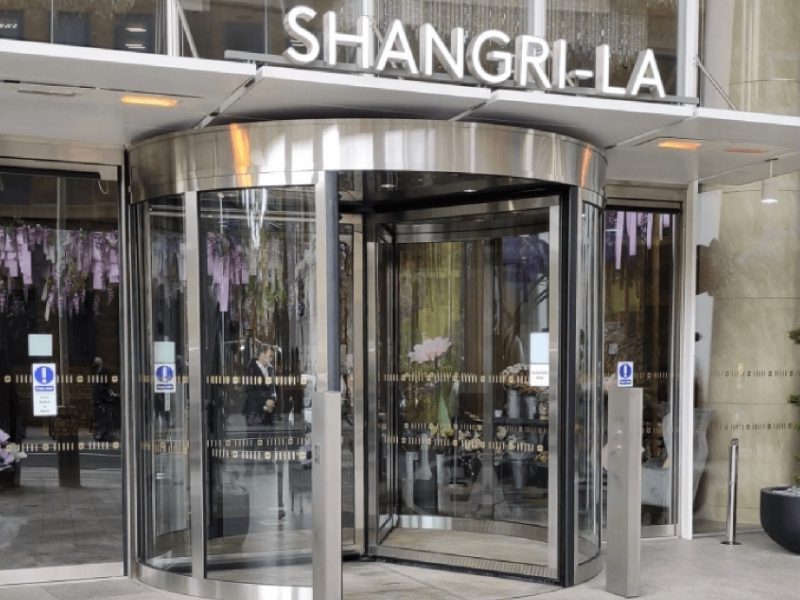Automatic revolving doors have grown in popularity, becoming a key entrance feature in modern commercial buildings. Offering a smooth entry, improved energy efficiency, and strengthening of building security, they’re a fantastic choice for many buildings.
But just like all automated systems, they must meet strict safety and compliance standards to remain legally operable and safe for public use.
In this blog, we’ll explore the key safety features, legal obligations, and maintenance requirements associated with automatic revolving doors. Whether you’re dealing with a high-capacity revolving door, an all glass revolving door, or a framed revolving door, staying compliant boosts safety and efficiency for your site.
The importance of automatic revolving doors in commercial buildings
Automatic revolving doors aren’t just about curb appeal, they’re so much more than that. Their primary roles include:
- Efficient traffic management: helping control the flow of people, especially in high-traffic settings.
- Energy conservation: reducing air infiltration, keeping indoor climates stable.
- Increased security: they can be integrated with access control systems for tighter commercial security
Perhaps you’re retrofitting a hotel lobby or designing a new shopping centre, either way, automatic doors in commercial buildings offer functionality and protection in one.
Understanding revolving door compliance
Now, let’s move on to compliance. Not just a guideline, compliance is a legal obligation. Revolving doors fall under several national and international standards, including:
- BS EN 16005: covers the safe use of power-operated pedestrian doors. Installers and maintenance professionals must be certified to this standard, such as our trained EA engineers.
- ANSI/BHMA A156.27: U.S. standard for power-operated revolving doors.
- While there are no specific UK power requirements similar to the ANSI/BHMA standard, compliance with BS EN 16005 ensures safe operation of powered revolving doors in the UK.
- Workplace Health and Safety Regulations: require building owners to make sure their doors are safe and maintained regularly.
- Equality Act and ADA compliance: revolving doors must be accessible to all users, including those with disabilities.
Automatic revolving door systems must be inspected regularly, with proper records kept in a door service log. This log tracks all compliance checks, safety inspections, and repairs – it’s a really important resource.
Important safety features in modern revolving doors
Revolving door compliance is essential, and systems should be equipped with advanced safety measures. So, what features do you need?
- Emergency stop buttons: allow users to halt door movement instantly.
- Speed control: prevents the door from spinning too fast and causing injury.
- Safety sensors: detect nearby objects or people and pause movement.
- Breakaway wings: offer emergency exit access during power outages or evacuations.
- Barrier and side screen protection: prevent access to dangerous zones within the door system.
All these components are crucial, especially in high-capacity revolving doors used in airports, hospitals, and shopping centres.
Legal obligations and regular safety inspections
As a building owner or occupier, it’s your responsibility to keep your automatic doors safe and compliant. What should be on your radar?
- Annual professional servicing: experts certified under ADSA (Automatic Door Suppliers Association) and trained in BS EN 16005 should carry out inspections and repairs. Our EA team are fully trained and compliant.
- Weekly safety checks: simple tests can be done in-house to make sure sensors, doors, and safety devices are working properly.
- Recording maintenance: every automatic revolving door must have its own log book to document service dates, findings, and repairs. These records should be kept for at least 12 months – be careful to store them somewhere safe!
Neglecting these checks could result in non-compliance, legal action, or injury to users. It’s not worth the risk of overlooking your obligations. If you’re not sure where to start, chat to our specialists about door compliance.
Tailoring maintenance for different door types
Each revolving door type is unique, and has unique maintenance needs:
- All glass revolving doors need routine cleaning and careful inspection of safety markings to avoid user injury.
- Framed revolving doors often house wiring and sensors inside the frame, requiring specific checks for hidden wear.
- High-capacity revolving doors may operate continuously throughout the day and require more frequent inspections.
Understanding these differences is key to maintaining safety and compliance, but it can get complicated to know what’s what. If you have any queries about your door compliance, chat to us.
How to create a compliance-first maintenance strategy
Developing a structured plan can simplify compliance. Consider the following:
- Partner with certified professionals: only technicians trained to BS EN 16005 should handle inspections and repairs, such as our EA team.
- Schedule quarterly service reports: these offer a full breakdown of your automatic door systems and help spot potential issues early.
- Use manufacturer guidelines: always follow the service schedule outlined in your installation documents or user manual.
- Educate staff: basic training on how to perform visual checks and report issues can be invaluable, if you need support training your team, we can help.
By planning maintenance properly and seeking expert support, you can reduce downtime, minimise long-term repair costs, and make sure that all doors remain compliant day after day.
Chat to our team about automatic revolving door compliance
Automatic revolving doors are excellent entry solutions, boosting security, traffic flow management and energy efficiency. But their advantages come with responsibilities. Legal compliance, user safety, and regular inspections are not optional, they’re a must, and building owners need to be proactive.
By understanding the standards for revolving door compliance, maintaining accurate service logs, and using qualified technicians, building managers can create a safe and efficient entry system.
It’s an investment in safety, reputation, and peace of mind. Interested in making your automatic revolving doors compliant? Have a compliance query, or want to see which revolving door might be right for your commercial building? Chat to our experts.





















